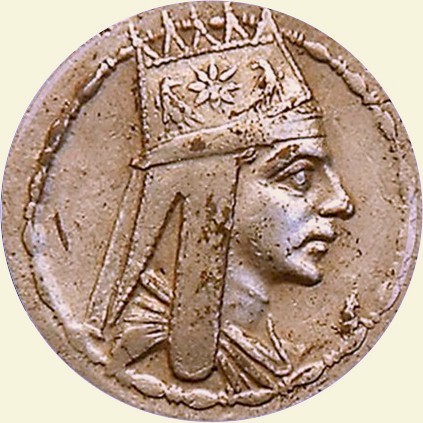Astute Armenian prince who
made his small kingdom in the Causasus a key catalyst in reshaping the
political map of the Near East, effectively bringing
Seleucid influence to an end. At the height of his power he ruled most
of the territory from eastern Asia Minor to the Caspian Sea & from the Black Sea to Phoenicia. Yet,
in the end, he was forced to retreat to the natural borders of his
mountain homeland.
Tigranes first drew historical
note as a royal hostage after his father was defeated by Parthia in 105
BCE. When the latter died (95
BCE), he bought his
freedom by ceding Armenian territory to his captors. Returning to assume
the Armenian throne he quickly allied himself with Mithridates VI of Pontus (a
grandson of Antiochus IV
Epiphanes) by marrying his daughter, Cleopatra.
Avoiding direct involvement in his father-in-law's challenges to Roman
dominance in Asia Minor, Tigranes initially focused on extending
Armenia's borders deeper into Asia.
Taking advantage of political turmoil in the Parthian empire after 88
BCE, he
not only regained the Armenian provinces he had lost but moved to take
control of northern Mesopotamia & Persia, even claiming the ancient Persian title "King of Kings" (85
BCE). Impressed by
these successes, Syrians--weary of years of civil war between rival
branches of the Seleucid dynasty--invited Tigranes to be their protector
(83 BCE). Over the next decade his forces gained control of the
remnants of Seleucid territory from Antioch to Damascus &
Ptolemaļs.
Flush with these victories, he offered his father-in-law refuge from the
Romans. His one strategic mistake was rejecting Roman demands to
surrender their long-time adversary. This led to a series of defeats & the loss of his Syrian
territory. When Pompey
invaded Armenia in 66 BCE Tigranes,
unlike his father-in-law, surrendered without a fight. As
a consequence Pompey allowed him to retain his throne providing he
relinquish conquests beyond his homeland. So the final decade of
Tigranes' 40 year reign was spent as a "friend (i.e., nominally
independent client) of Rome."
Reference:
Strabo,
Geography 11.14.15.
Other resources on line:
![]()
![]()

![]()
![]()
![]() Perspective on the World of Jesus
Perspective on the World of Jesus ![]()